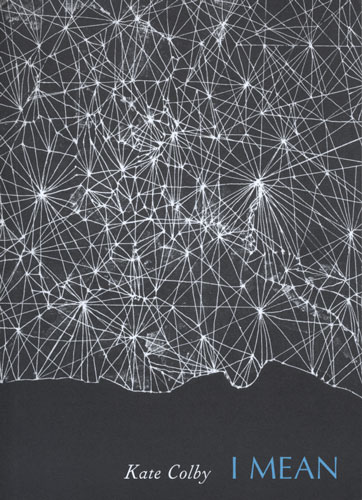I Mean
Innovative forms written by literary warriors like Kate Colby illustrate the breadth of structural opportunities in contemporary nonfiction. In the case of Colby’s I Mean, the writer approaches poetry with dynamics and patterns perhaps otherwise expected of prose, and even repeats those techniques in prose. Innovative forms written by literary warriors like Kate Colby illustrate the breadth of structural opportunities in contemporary nonfiction. In the case of Colby’s I Mean, the writer approaches poetry with dynamics and patterns perhaps otherwise expected of prose, and even repeats those techniques in prose.
Having already authored half a dozen books, Colby’s I Mean includes a long poem plus lyric essays exemplary of the highest expression of today’s nonfiction. Colby tries to suss out herself as a writer and the writing process throughout the opening poem. Some other topics under discussion here are place and art. The thread tying these pieces together is a parabolical meta-cognitive approach, one almost palpable enough to see parabolas form on and between the pages. (The book cover captures this quality perfectly.)
The book opens with her long, eponymous poem. It’s gorgeous enough to induce readers into throes of literary passion. Its dynamics range from small bumps that repeat often and compellingly and move to larger and still larger ones. She does this through repeated and various approaches to understanding the writing process, which reveals Colby’s mastery of dynamics and outstanding control. This is especially meaningful because one gets the sense that, while her persona never seems scattered, she swerves from knowing approximately what she wanted to say to great doubt.
This dynamic expression finds its match in the author’s tremendous depth of examinations as she looks for meaning in semantics, diction, even her previously published work. Within two pages she’s moved from the unsure placement and replacement of one word for another, stepped back to look at the entire piece to wonder what she’s trying to write, and finally into that stage where we hit the delete all buttons. It reads like this:
I mean I’m going to talk about it
I mean talk about it
by talking about
talking about it
I mean write about it
I mean scrape it all towards me
With the edge of my hand
I mean like a spray of crumbs
I mean pile
I mean to pile up
And get on top of.
Advancing into the section of four lyric essays, “The Longest Division,” however, the novelty of her techniques wears off and even starts to wear on the reader. A gradual yet definite disconnection ensues. Here travel writing, personal essay, memoir, literary reportage, and ekphrastic elements combine.
The first essay, “Rainbow Swash,” discusses a piece of public art of Ho Chi Minh’s profile and a rock formation resembling an old man’s face. Art, the changing values of a populace, and even the decay of time are all topics under consideration. Finding a more succinct theme, though? That’s the challenge that unfortunately makes the section start to feel scattered and incoherent, intentionally in some cases, but then increasingly in a direction the author didn’t likely intend.
The second essay, “Slingshot Ouroboros,” seems like Colby’s artist statement and is almost a prosaic mirror of the opening poem. For example, “But I have a sense that I can only get there by saying—exhausting myself via words, exhausting words.”
It’s in “Ring Road” the repetition of techniques grows wearisome and the topics too abstract or dense. It’s tough not to think she’s being convoluted just to show that she can be. What starts as a travel piece based on Isabella Stewart Gardner’s museum ends up as confusing as rebuilding a Sol le Witt installation without the artist’s precise instructions. Here’s an example from the essay’s beginning:
Place flickers and moves from beneath you, like a fuzzy gray dot at the intersections of a black-and-white grid. Just when you get there it’s gone to the corner of your eye.
From the museum she bounces over to Freud and to Susan Howe, a writer whose “borderless place,” she writes, “is made of fractured ruins of many minds and memories that run away like grid-dots as you get near them.” By this point it seems Colby has obliterated the connection with at least this reader-writer.
In the end, though, it’s most likely the reader will return like a touchstone to Colby’s poem and the first couple of essays. There’s some structural genius here, one exemplary of a well-controlled literary style.





